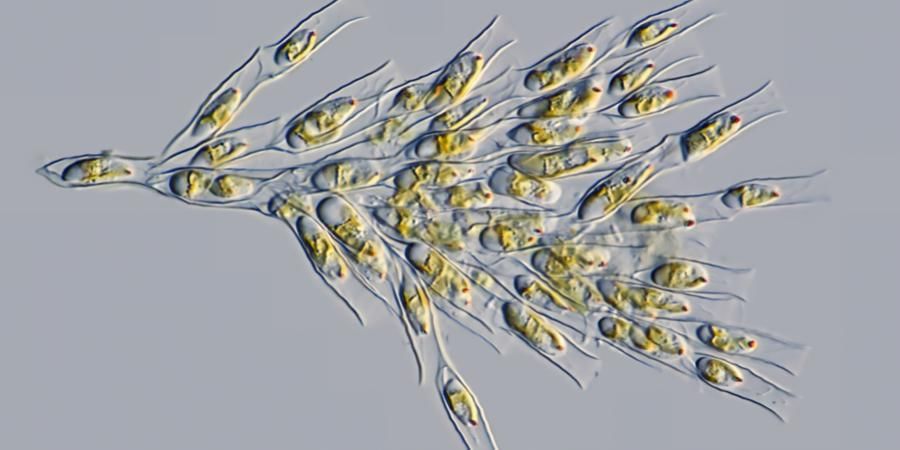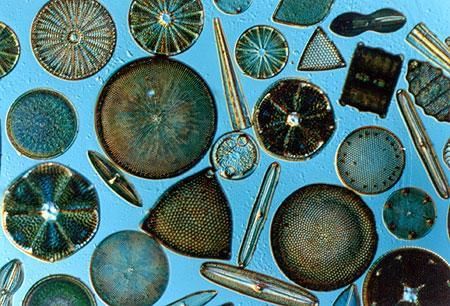NEET Exam > NEET Notes > Additional Study Material for NEET > Introduction to Chrysophytes
Introduction to Chrysophytes | Additional Study Material for NEET PDF Download
Introduction
- Chrysophytes are plant-like protists that can be found in marine and freshwater environments which are often low in calcium.
 Chrysophytes
Chrysophytes
- There are three main types of chrysophytes: Diatoms (Bacillariophyta), Golden-brown algae (Chrysophyceae), and Yellow-green algae (Xanthophyceae).
- Although many are unicellular and free swimming, some chrysophytes, like the dinobryon above, join together and form colonies.
- There are over 1000 described species of Chrysophytes, and, because there are so many species, there is no common cell structure shared by them.
- Some species have cell walls made of cellulose strengthened by silica compounds, while others are amoeboid without any cell walls.
➢ Methods of Feeding, Movement, and Reproduction
- Since chrysophytes are plant-like and have chloroplasts, they are mainly autotrophic.
- If there is inadequate lighting, they can become heterotrophic, especially in areas with high dissolved foods concentrations.
- Chrysophytes are mainly non-motile, but they do have two flagella for movement in harsh conditions.
- Most chrysophytes reproduce asexually through meiosis, but diatoms reproduce sexually, dividing and exchanging parts under certain conditions.
➢ Chrysophyta Relatives, Affect on Humans, and Role in Food Chain
- Chrysophyta is algae, so their closest relatives are the six other divisions of algae: Euglenophyta, Pyrrophyta, Chlorophyta, Rhodophyta, Phaeophyta, and Xanthophyta.
- Being the main components of plankton and nanoplankton, diatoms and Chrysophyceae are the foundation of the marine food chain, functioning as the producers.
 Diatoms
Diatoms
- Chrysophyta can be considered helpful to humans. We use them in toothpaste, scouring products, and filters.
- As autotrophs, they provide a substantial amount of oxygen in the atmosphere, as well.
- Also, because chrysophytes store their food as oils, they can be used for biofuel.
- Diatoms are especially effective in biobutanol production because of their small size.
The document Introduction to Chrysophytes | Additional Study Material for NEET is a part of the NEET Course Additional Study Material for NEET.
All you need of NEET at this link: NEET
|
26 videos|287 docs|64 tests
|
FAQs on Introduction to Chrysophytes - Additional Study Material for NEET
| 1. What are chrysophytes and why are they important? |  |
Chrysophytes are a group of algae that belong to the division Chrysophyta. They are important because they play a significant role in aquatic ecosystems as primary producers. They are known for their ability to photosynthesize and produce a large amount of oxygen. Additionally, some chrysophytes are indicators of water quality and can be used as bioindicators in environmental monitoring.
| 2. How do chrysophytes obtain their energy? |  |
Chrysophytes obtain their energy through photosynthesis. They possess chloroplasts, which contain chlorophyll and other pigments that capture sunlight. Using these pigments, they convert sunlight into chemical energy, which is then used to synthesize organic compounds, such as glucose, through the process of photosynthesis.
| 3. Can chrysophytes live in both freshwater and marine environments? |  |
Yes, chrysophytes can live in both freshwater and marine environments. They are found in a wide range of habitats, including ponds, lakes, rivers, and oceans. Some chrysophytes are more commonly found in freshwater, while others are adapted to survive in marine environments. Their ability to thrive in various environments contributes to their ecological importance.
| 4. Are chrysophytes harmful to humans or animals? |  |
Most chrysophytes are not harmful to humans or animals. In fact, they are an essential part of the food chain in aquatic ecosystems, providing food for many organisms. However, some chrysophytes can produce toxins under certain conditions, leading to harmful algal blooms. These blooms can negatively impact the water quality and ecosystem health, causing harm to fish, shellfish, and other aquatic organisms.
| 5. How do chrysophytes reproduce? |  |
Chrysophytes reproduce through both sexual and asexual methods. Asexual reproduction is common and occurs through cell division, where a single chrysophyte cell divides into two identical daughter cells. Sexual reproduction involves the fusion of gametes, which are specialized reproductive cells. This process leads to the formation of zygotes, which develop into new chrysophyte individuals.
Related Searches























